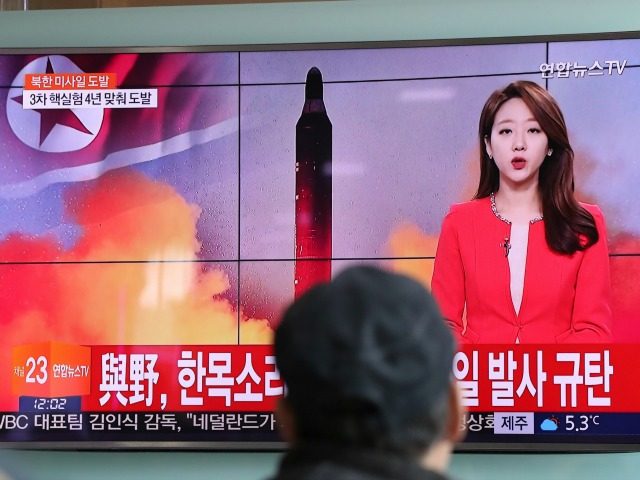This past weekend brought the world another banned missile launch from North Korea followed by another emergency UN Security Council meeting. Another round of diplomatic tough talk and sanctions is surely on the way.
On February 12, North Korea launched a Pukguksong-2 intermediate-range ballistic missile (IRBM). A decade of sanctions has not deterred the Hermit Kingdom from pursuing its goal of developing long-range, intercontinental ballistic missiles (ICBM) with nuclear warheads which could target the U.S. homeland. Yet, the Trump Administration has an opportunity to escape from the tit-for-tat cycle of following each North Korean missile test with yet more ineffectual sanctions.
President Trump should order the Secretary of Defense to position American assets and shoot down Kim Jong Un’s next missile launch. Intercepting a North Korean missile would signal to Pyongyang that America has the capability and the willingness to defend our allies and the homeland. In the parlance of military strategy, the missile defense option enhances deterrence-by-denial. North Korea is more likely to be deterred from developing missiles if robust, layered missile defenses deny them any strategic benefit from striking first. The only two alternatives are preemptive offensive action and, of course, more strongly worded UN Security Council resolutions and toothless sanctions.
In July 2006, North Korea abandoned seven years of good-faith multilateral negotiations by testing seven ballistic missiles – including the Taepo Dong-2 nuclear-capable ICBM. Shortly thereafter, the United Nations Security Council adopted Resolution 1695 condemning the launches and demanding that Kim Jong-Il’s regime returns to multilateral talks and the previous launch moratorium.
North Korea has responded subsequently by conducting over 30 banned missile launches and nuclear tests. Like clockwork, the United Nations and the United States responded to these violations with over 20 actions to establish, expand, or reaffirm sanctions. This weekend’s missile test followed the latest UN Security Council Resolution (2321) enacted in November 2016. Clearly, a decade of sanctions has not changed Pyongyang’s behavior. While the diplomats tussle in Turtle Bay, North Korea’s missile and nuclear programs move steadily forward.
Cleary, U.S. and international diplomatic and economic instruments of power are insufficient – even combined with allies and partners. Continually signaling impotence weakens the trust of Japan, South Korea, and the American people.
So, what change is needed? Should we pursue diplomatic efforts? Yes. Should we enhance economic sanctions? Yes. It’s time to back up those options with a credible show of defensive military force.
Can America’s armed forces actually “hit a bullet with a bullet”? Absolutely. Led by the Missile Defense Agency (MDA), the U.S. military has constructed a Ballistic Missile Defense System (BMDS) over three decades. The BMDS represents an integrated and layered network of sensors (ground-, sea-, and space-based), interceptors (ground- and sea-based), and command-and-control nodes that provide an umbrella of protection from inbound ballistic missile threats.
The Aegis BMDS system would likely be used to defeat a North Korean threat. Aegis is a combination sensor-shooter system capable against short- to intermediate-range ballistic missile threats for regional defense. The system also supports homeland defense through its detection and tracking capabilities. The United States has 16 Aegis BMD ships assigned to Pacific Fleet complemented by Japan’s four deployed Aegis BMD-capable KONGO Class Destroyers. Since 2002, Aegis BMD has a stellar test record — 34 hits (3 with Japanese KONGOs) and only 6 misses. Aegis is well suited to shoot a Pukguksong-2 or Musudan out of the sky.
American taxpayers have provided more than $180 billion to the MDA since 1985, including more than $16 billion for Aegis. It’s time to put the hard-earned treasure of the American taxpayer to work.
Absent use of defensive intercept, the military alternative is preemptive strike to take out North Korean missiles on the pad. Incidentally, two former Secretaries of Defense – Ashton Carter and William Perry – recommended preemptive strike a decade ago. The difference today is that operational missile defenses provide the option to reinforce deterrence and assure allies without necessarily escalating to offensive action.
President Trump should direct Secretary of Defense James Mattis to posture our ballistic missile defense forces in the Pacific theater to intercept any and all future North Korean ballistic missile launches. A forceful military response – backing up diplomacy and sanctions – may help deter further ballistic missile and nuclear development.
Congressman Jim Bridenstine, a Republican, represents Oklahoma’s First District and serves on the House Armed Services Committee. Bridenstine is a combat veteran of Iraq and Afghanistan and currently an Air National Guardsman with the 137th Special Operations Wing in Oklahoma City, OK.

COMMENTS
Please let us know if you're having issues with commenting.